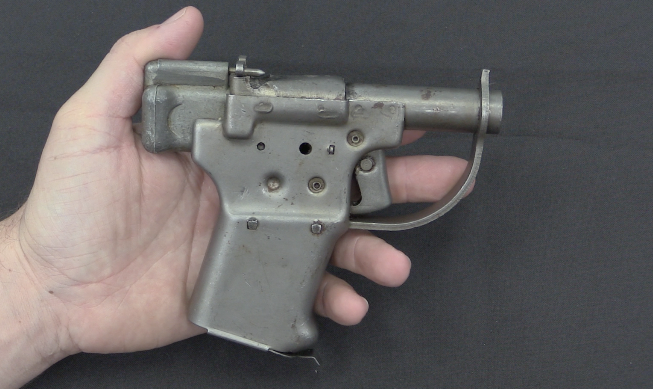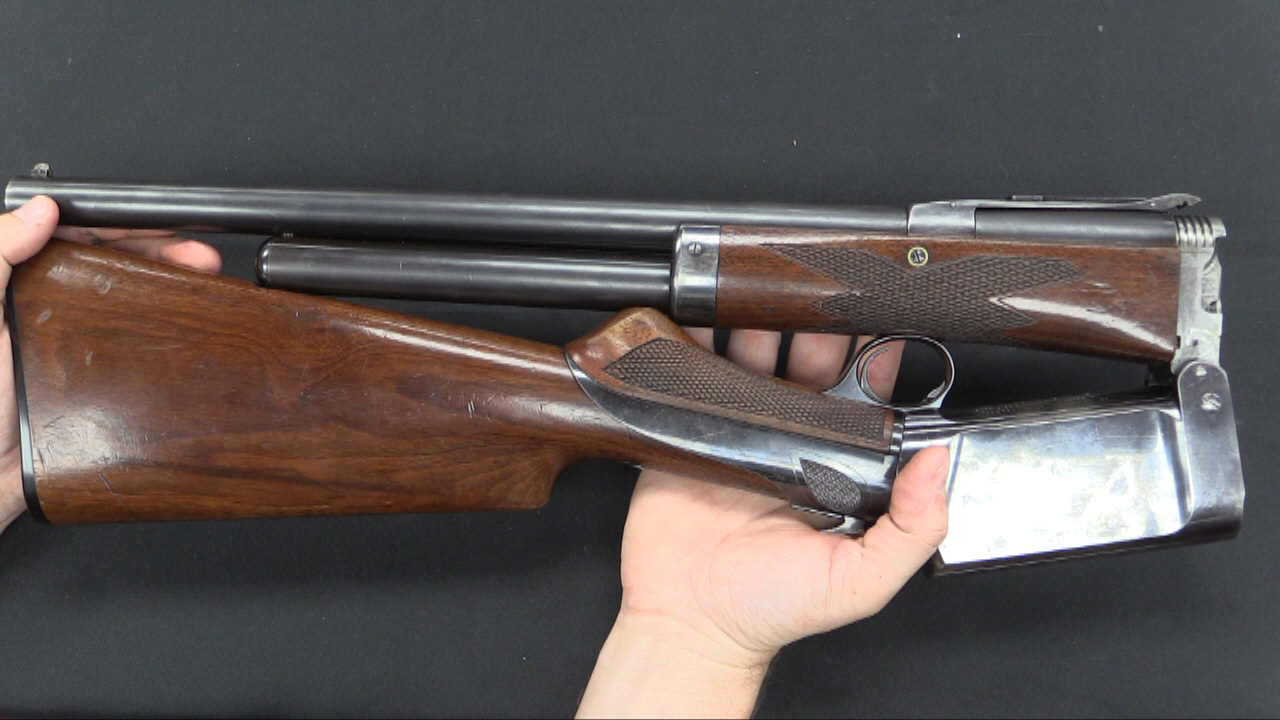When Winchester first began producing Model 1895 rifles, they made a model that only lasted a short time. Between serial numbers 5000 and 6000, the first pattern 95s were replaced by a second pattern of the design, which changed several elements. The most notable was the receiver profile, which went from a flat sided slab to one with a scalloped relief cut. Most substantially, the safety mechanism which prevented out of battery firing was substantially improved in the second model, with the distinctive spring loaded lower element of the action lever. First pattern Winchester 1895s are quite rare, especially in a condition as nice as this one!
Related Articles

Handgun
FP-45 Liberator at RIA

Accessories
XM-2 Personnel Detector

Shotgun

Isn’t Pedersoli or someone making a replica of the 1895? I’ve always thought that this was a quite forward thinking design.
Forward thinking is right. The design is practically ambidextrous, good enough for military grade rounds, and it cycles a bit quicker than most rotating bolt action rifles. The problem is maintaining the receiver, especially if we throw trench mud into it. And is the Winchester 1895 more expensive than the M1903 Springfield in terms of production costs?
As Ian and Karl have shown on InRangeTV, Winchester 1895 performed quite well in the mud. Better than most bolt action rifles of WWI.
Okay I stand corrected. But how did the 1895 Winchester compare in price tag to a Springfield M1903? And if I remember correctly the Army didn’t want to pay production license fees to Winchester (the same issue that the French army had with Hotchkiss guns, intellectual property quarrels). I could be wrong again.
Winchester did well in mud test, but as Ian and Karl stated in one of videos any gun will function while mud is outside and will fail after enough dirt and mud get inside and jam the action. Win 95 very good at holding mud outside… until you start to work the action. It is only matter of time, when gun fired in muddy trenches with dirt flying in the air. Cleaning lever-action rifle (with disassembly!) looks far more complex than almost any existing bolt action.
The M1903 was not a cheap rifle to manufacture
Although it required fewer distinct machining operations on the receiver than the Krag models which it replaced, (off the top of my head something like 98 3/4 compared to 115)
The m1903 design was needlessly complex to machine, and for little or no gain in functionality or user safety.
It’s a fine example of the socialist calculation problem ( socialism is incapable of ratonal economic calculation).
And represents something of a job creation scheme for the machinists who were already employed in the state sector arsenals.
The 1895, represents a far more mature design
One in which careful thought and attention to detail has been given to ergonomics, functionality, and to multiple levels of redundancy in user and bystander safety
Browning designed first of all for the user, not to make work for under employed arsenal staff,
He also (at a second level of importance ) designed for manufacturing.
He and his brothers, and their father before them, were gun makers.
They had to be able to manufacture guns to a price that allowed enough margin for them to eat.
Arsenal manufacture does not have that discipline
The tax victims don’t get a choice, they are forced to pay for whatever idiocy the arsenal comes up with
And, without having any skin in the game, you can bet that the arsenals will manage to come up with plenty of idiocy
In 1985, Browning came out with their 1895 copy in 30-06. I bought one new and it is very nice! It was made in Japan by Miroku who makes Browning’s competition shotguns. Later, Miroku also made a reintroduced 1895 for Winchester, altho’ it was modified with a tang safety and rebounding hammer. The new Winchester was offered in .405, .30-40 and .30-06.
Another great video Ian..
Ian,
Would you let us know what this piece goes for?
I wondered this isn’t the same sort of thing that those WWII Commemorative Colt 45s are that you used to see advertised from Franklin Mint or the like, in gun magazines, for four easy payments of 200.00.
A functional wall hanger, especially given the musket length.
If anyone wonders why the musket appellation was applied here, it’s a long arm with a full-length stock as opposed to the sporting/hunting stocks fitted to most civilian long arms. This terminology also implied that the weapon in question could be fitted with a bayonet (and indeed, several Winchester musket-styled rifles were sold with spike bayonets, though the 1895 model came with a sword bayonet). However, the full-stocked muskets were never really popular if memory serves well (presumably because nobody does ride-by bayoneting in the Old West). Any corrections need be applied here?
Something like half of the 1895 production were muskets – for the Imperial Russian Army during World War 1. But most civilian models were shorter with sporting stocks.
True, musket stocks were best used in military applications (for obvious reasons). And as I said before, almost nobody on the civilian market needed the full stock unless he were part of a local militia that tended to personally tangle with border jumpers at punching distance on a daily basis.